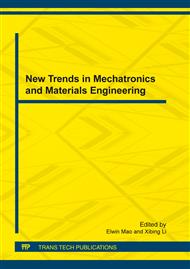[1]
A. Scholz and C. Berger: Deformation and life assessment of high temperature materials under creep fatigue loading, Mat. -wiss. u. Werkstofftechn. 36, No. 11, pp.722-730 (2005).
DOI: 10.1002/mawe.200500941
Google Scholar
[2]
W. Ramberg and W.R. Osgood: Technical Report No. 902, NACA (1943).
Google Scholar
[3]
F.H. Norton: The creep of steel at high temperature, McGraw Hill, (1929)
Google Scholar
[4]
S. Taira: In: Structures, pp.96-119, N.J. Hoff (Ed.), Academic Press, (1962).
Google Scholar
[5]
L. Cui: Zum Einfluss der komplexen Kriechermüdungsbeanspruchung auf die Lebensdauer am Beispiel des Turbinenwerkstoffes X12CrMoWVNbN10-1-1, Dr.-Ing. Diss., TU-Darmstadt, D17 (2011).
Google Scholar
[6]
H. Haase: Betriebsähnliches Langzeitdehnwechselverhalten moderner martensitischer 9 bis 10%Cr-Stähle, Dr.-Ing. Diss., TU-Darmstadt, D17 (2004).
Google Scholar
[7]
M. Schwienheer: Hochtemperaturverhalten der 600°C-Dampftubinenstähle (G)X12CrMoWVNbN10-1-1, Dr.-Ing. Diss., TU-Darmstadt, D17 (2004).
Google Scholar
[8]
A. Samir, A. Simon, A. Scholz and C. Berger: Service-type creep-fatigue experiments with cruciform specimens and modelling of deformation, Int. J. Fatigue, Vol. 28, Iss. 5-6, pp.643-651 (2006).
DOI: 10.1016/j.ijfatigue.2005.08.010
Google Scholar
[9]
Draft International Standard ISO/DIS 12111, ISO/TC 14/SC 5, 2009, Metallic materials – Fatigue testing – Strain-controlled thermomechanical fa-tigue testing method
DOI: 10.3403/30096503
Google Scholar
[10]
S. Zhang and M. Sakane: Multiaxial creep–fatigue life prediction for cruciform specimen, Int. J. Fatigue, Vol. 29, Iss. 12, pp.2191-2199 (2007).
DOI: 10.1016/j.ijfatigue.2006.12.012
Google Scholar
[11]
P. Wang, M. Lyschik, A. Scholz and C. Berger: An extrapolation method applied to a constitutive material model to recalculate creep fatigue experiments, the 9th Intern. Conf. on Multiaxial Fatigue & Fracture (ICMFF9) Parma (Italy), 7 - 9 June, 2010.
DOI: 10.1016/j.ijfatigue.2012.04.018
Google Scholar
[12]
P. Wang: Fortschrittliche Methoden zur Anwendung bei einem konstitutiven Materialmodell für Kriech- und Kriechermüdungsbeanspruchung, Dr.-Ing. Diss., TU-Darmstadt, D17 (2011), in print.
Google Scholar


